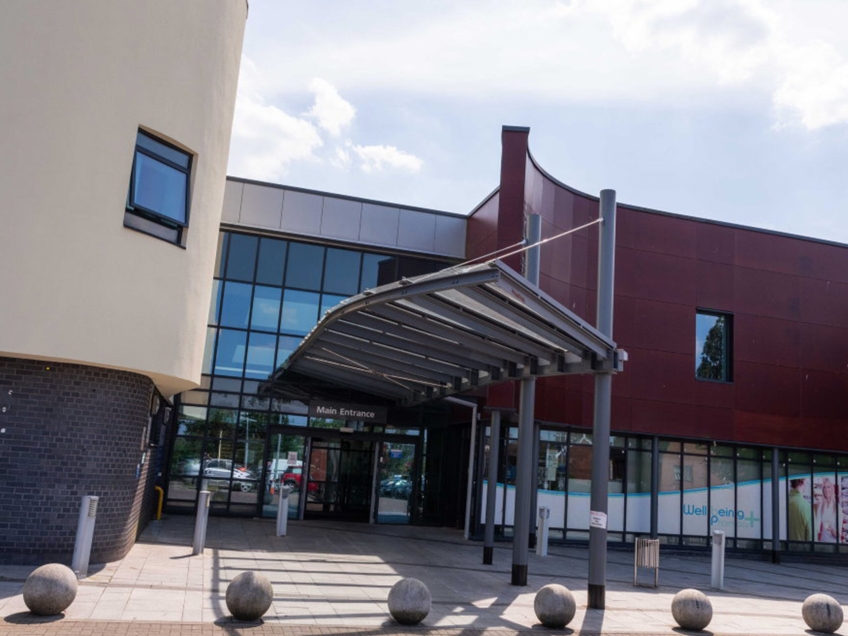
Enthusiasm alone won’t build Neighbourhood Health Centres
Published date: October 2025
It’s time for an honest debate. Everyone agrees that neighbourhood health and care is the answer to reviving an ailing NHS. What isn’t changing are the structures and frameworks that stifle progress.
The UK’s healthcare system is at a crossroads. The government has ambitious plans to transform the NHS with a new vision for neighbourhood health centres. Yet, outdated valuation systems and rigid funding models seriously threaten progress.
Here we confront the issues challenging the government’s vision:
- The existing 3PD model is no longer a suitable mechanism for the delivery of new health hubs.
- Rigid valuation frameworks for NHS healthcare facilities have created a vicious cycle, where outdated methodologies obstruct the progress essential for a reformed health service.
- There is a lack of agreement, accountability, and action on the steps needed to unlock progress.
In this article, we break down these barriers and invite respected industry experts to share their perspectives on the solutions needed to turn headlines into tangible, transformative infrastructure for a 21st-century NHS.
A renewed approach to healthcare delivery
The government’s rallying cry is clear: the NHS needs a radical overhaul to build a healthcare system fit for future generations. In the long-awaited 10 Year Health Plan for England, an evolutionary plan for a new model of care has emerged. For too long, the NHS budget has not been spent where it should be. Despite hospital staff numbers increasing sharply, waiting lists have only increased, while productivity has fallen.1
A primary goal of the government’s NHS plans is to move most outpatient care out of hospitals by 2035, a shift to be facilitated by the creation of 250-300 Neighbourhood Health Centres.2 These facilities form a cornerstone of the plans to reform the NHS, delivering integrated healthcare in the heart of communities.
In a fundamental rewiring of the NHS, the creation of the facilities will see a shift from reactive hospital care to proactive community and preventative health. Supported by pooled budgets and enhanced strategic guidance, Neighbourhood Health Centres are intended to facilitate an expansion of integrated, multi-professional teams working in close collaboration under one roof.3 In addition to alleviating pressure on over-burdened hospitals and widening service access, this renewed approach aims to improve outcomes and support for the most frequent users of health and welfare services. Data suggests that at present, the 7% of the population with the most complex health and care needs account for 46% of hospital costs.4
For every £100 invested in community care, the NHS sees an average 31% return on investment through reduced acute hospital activity — equivalent to a net saving of around £26 million for an average Integrated Care System.
Source: NHS Confed
Reimagining the future: What’s in a Neighbourhood Health Centre?
NHS England has established that these facilities should include core components, including: population health management, modern general practice, standardising community services, neighbourhood multi-disciplinary teams, integrated intermediate care and urgent neighbourhood health services.5 With each centre structured to meet the specific needs of their population, these ‘one-stop-shop’ facilities can include:
GPs & out-of-hospital nurses
Diagnostics services (e.g., MRI, X-rays, ultrasounds)
Urgent care & outpatient services
Physios & care workers
Pharmacists
Mental health services
Debt & Employment advice
Complementary community services
A successful blueprint for a neighbourhood health service is the Prime delivered project, Washwood Heath Health and Wellbeing Centre. Set up in a deprived Birmingham neighbourhood, this Prime supported project has combined state-of-the-art healthcare facilities with social support services, private healthcare and community facilities within an inclusive, welcoming and accessible environment.

It’s time for the debate to shift from the ‘what’ to the ‘how’. The vision is clear, the roadmap less so.
While everyone agrees on the answer to the pressing challenges facing the NHS, the pathway to achieving these ambitions is still obscured by significant obstacles. For too long, current NHS funding structures and capital budget constraints have challenged the development of new public healthcare infrastructure. These are challenges we have explored in depth in our insight articles, Strengthening the NHS, not selling it out and Deliver or Delay? The escalating cost of inaction on NHS trusts and GP estates. However, an additional obstacle now presents a real threat to the development of Neighbourhood Health Centres: current structures for the development and valuation of health care facilities.
To ensure access to the appropriate level and sources of funding, new Neighbourhood Health Centres must have their value distinguished from legacy primary care infrastructure. They cannot be compared or valued in the same way as a traditional GP’s surgery, just as you wouldn’t value a smartphone in the same way as a landline phone. While both have their purpose, their scope and functionality are on a different scale. The same must become true regarding the valuation of existing primary care infrastructure and the proposed new health hubs — they command a different type of assessment.
Current valuation systems for healthcare infrastructure fail to properly account for their long-term public service value, integrated care benefits, and strategic importance to the NHS.
A much-needed change to our NHS is on the horizon. However, going beyond the headlines to realise this ambitious transformation requires a new approach to how healthcare infrastructure is valued, funded, and operated. Building physically robust and commercially viable infrastructure requires not only significant capital investment but also a complete overhaul of existing planning frameworks to strategically align investments with appropriate estates, skilled workforces, and vital resources.
In the following chapters, we explore the challenges hindering this progress, drawing on insights from industry experts to pinpoint the critical areas where change must happen if we are to equip the NHS with the facilities it needs to survive and thrive.

Strengthening the NHS, not selling it out...
Read article
Deliver or Delay? The escalating cost of inaction on NHS trusts and GP estates...
Read articleChallenge 1
The 3PD model, which has delivered many GP premises, is outdated and not appropriate for the delivery of Neighbourhood Health Centres
The Third-Party Development (3PD) model has been the traditional mechanism for developing new primary care facilities. However, as service delivery methods rapidly change, these models fail to supply infrastructure that is different in its design, structure, and occupancy to meet the needs of 21st-century healthcare delivery. A recent survey showed that a staggering 83% of Practice Managers say their premises are not suitable for future needs and don’t have enough space for additional staff on site, with 50% saying their premises aren’t even fit for current needs.6 While still a viable option for smaller-scale schemes, its narrow focus on long lease terms, GP occupancy, and single-purpose design means that this model isn’t an effective or suitable vehicle for the development of new Neighbourhood Health Centres — here’s why:
- While GPs traditionally owned their practices, the shift to 3PD models with their long, binding lease lengths makes direct ownership much less appealing for current practitioners.
- The government’s ambitions prioritise integrated healthcare, but most existing primary care infrastructure cannot adapt its existing spaces to meet these changing needs, increasing the imperative for new, purpose-built infrastructure.
- Service provision needs to move from hospital to community settings; however, existing 3PD suppliers are operating at near full capacity, increasing the need for purpose-built neighbourhood facilities. For example, PHP’s recent results show up to 99.1% occupancy.7
Sarah LivingstonIt is disingenuous to compare older estate rents, delivered in a different era of building costs, land values and funding rates, to current needs. This approach makes landlord-tenant relationships adversarial, with landlords focused on longer leases over improving the quality of buildings. NHS commissioners should instead understand modern building costs through open-book style developments, a proven public-private method. Commissioners should also evaluate the holistic financial benefits of moving services out of hospitals into community settings for improved patient health outcomes.’
Head of Healthcare, CBRE

Overcoming the challenge:
Solutions for a new model of integrated care
Responsibility: The NHS should lead the vision for integrated care, supported by the skills and resources of an experienced partner with real estate experts.
- The NHS 10 Year Health Plan sets out the direction of travel and the aspiration of the government to change how the NHS operates to become more neighbourhood-focused, moving services away from hospitals and delivering more care closer to where people live. The NHS should focus on making that work from an operational perspective and should work with experienced healthcare real estate professionals to reshape its healthcare estate to support these changes.
- To support the development of next-generation healthcare infrastructure, we must bridge the capital gap by strengthening public-private collaboration and attracting institutional investment. Through smart partnerships with institutional investors, the effective transformation of NHS infrastructure is possible, without compromising the core values at the heart of our healthcare system.
Challenge 2
The current property valuation system for healthcare infrastructure is too inflexible
The fundamental flaw at the heart of the UK’s healthcare infrastructure crisis lies in an ineffective and inflexible property valuation system. In owner-occupied GP practices in the UK, the District Valuer (DV) is responsible for assessing the current market rent (CMR). CMR is then used in agreeing new rents and also as a base when agreeing rent reviews on legacy estate. Unfortunately, this ‘one-size-fits-all’ approach to valuing healthcare estate is based on archaic frameworks that fail to differentiate effectively between the entire legacy GP premises portfolio and the modern healthcare infrastructure proposed in the NHS’s 10 Year Health Plan. It is argued that the dual role performed by the DV creates a conflict of interest, in which there is hesitancy to approve the higher rents necessary for new healthcare infrastructure due to concerns that it will set a precedent for rent reviews on legacy buildings, despite their very different uses and forms.
It’s a critical dilemma that is creating a standstill in healthcare development and making urgently needed new developments unviable.
Why?
- Suppose the DV agrees to an increased CMR for new projects, like a Neighbourhood Health Centre. This can create pressure to raise rents for all other primary care premises, regardless of age, condition, or location, placing an unsustainable burden on already stretched NHS budgets.
- On the other hand, if the DV assesses modern, integrated care facilities by the same marker as legacy buildings, keeping rents artificially low in the process, the development of these schemes becomes completely unviable.
With more Neighbourhood Health Centres anticipated to be developed under a PPP model in which the NHS has a part-ownership interest,8 the focus shifts from reimbursing individual practice costs to strategically investing in public infrastructure. While current GP valuation systems are largely driven by market principles, the shift towards integrated, community health requires a collective acknowledgement that value is not simply measured in market rent or capital value but in its broader contributions to health outcomes, reduced hospital admissions, and ability to address health inequalities.
David BatchelorIt should come as no surprise that the District Valuer-led system of valuing healthcare assets has run up against the same limitations as the wider rating system also delivered by the District Valuer network. It’s just what happens when a system is fundamentally inward and backwards-looking whilst trying to keep up with dynamic and complex market interactions. To unlock this challenge, we need a new mechanism for ensuring a fair allocation of value and a failsafe against market abuse and incompetence.’
Managing Director of Operational Real Estate, CBRE

Overcoming the challenge:
Steps towards a fairer, more effective valuation process
Responsibility: Collaboration between the NHS and legacy landlords to agree on a revised process.
- Assess recommendations from the NHS Confederation report, Towards a new co-investment model: what is next for NHS public-private partnerships?, and leverage the most suitable solutions on a project-by-project basis to avoid a ‘one size fits all’ approach.
- Build a valuation framework that prioritises strategic public investment, integrated service delivery, and the broader social and health outcomes for communities. This requires a move towards a ‘value-based approach’ that considers the long-term benefits and effectiveness of the infrastructure in achieving NHS goals.
- A revised solution could include moving all rent reviews to an index-linked basis (RPI or CPI) with a cap and a collar. This would allow the District Valuer (or Valuation Office Agency) to focus on agreeing a fair rent for new developments on a cost-plus basis, acknowledging that no two properties will ever be identical in form or cost.
- By moving to an indexed base system and formally acknowledging the inherent differences between legacy GP premises and these innovative new models, we can alleviate the pressure on District Valuers to apply similar rent increases across an incomparable portfolio. Under this revised approach, we can foster a more equitable and sustainable funding environment for both existing and future primary care estates.
Realising the NHS’s future vision hinges on a collective acknowledgement of the fundamental differences between legacy GP premises and innovative healthcare models.
Challenge 3
A lack of accountability and action to unlock the obstacles stalling progress
Nobody can deny that there is a strong consensus that delivering integrated care at the heart of communities is the right step towards addressing the NHS’s challenges. But let’s be honest, while Neighbourhood Health Centres have created a lot of buzz after the release of the NHS 10 Year Health Plan, the concept of strengthening community-based services is not radical.
Phil HollandThe conversation about moving care from hospitals into the community has been happening for over 20 years — it’s a frustrating reality that highlights that without a clear roadmap for implementation, we risk another decade of stagnation. At Prime, we’re committed to driving a different approach that engages decision-makers, unites the industry, and transforms discussions into tangible, achievable solutions.’
Chief Investment Officer, Prime plc

The vision for integrated healthcare, centred on neighbourhood facilities, holds a powerful, self-fulfilling potential. Once established and operating, the inherent value of Neighbourhood Health Centres becomes clear: their enhanced functionality and co-located services attract a broader range of service providers, increasing demand for occupancy. In building these facilities in strategic locations and delivering long-term value to communities, investors also benefit from the security of a stable, long-term investment, but via a model that delivers the advantages of flexible funding and occupancy terms to the NHS.
However, achieving this level of progress and success hinges on removing the existing valuation and funding obstacles. Uniting the NHS, private healthcare providers, healthcare developers, strategic investors, and government bodies around this issue is critical if we are to deliver lasting, sustainable progress. Without action, we risk increasing the burden on hospitals, to the detriment of patient health, staff wellbeing, and the future financial health of the NHS.
Overcoming the challenge:
A revised and nationally recognised framework to value and finance hubs appropriately.
Responsibility: A Department of Health consultation has started this conversation.
- A new consultation on public-private funding partnership (PPP) models for primary and community health infrastructure is currently underway, considering factors such as procurement routes, funding structures and facilities management models. The ambitions of this consultation are to gather insights and learn from historic challenges surrounding procurement, service and risk allocation. However, to deliver the bold outcomes that are part of the NHS vision, the consultation should broaden its scope to also consider the innovative funding structures that have been used since the last PPP was closed. With a broader approach, a wider range of solutions could be uncovered, including an exploration of flexible building occupation that allows for changing healthcare needs over time, revised models for rent assessments and greater understanding of how new models can coexist with the existing 3PD market. While the consultation is unlikely to deliver all of the necessary real estate, it can form the basis of what is delivered elsewhere.
In summary
Space for Health: A proven solution for out-of-hospital services
At Prime, we are committed to not just delivering infrastructure for a new model of care, but are actively championing the solutions and policy decisions that can positively shape the future of healthcare. Having worked across the whole of health and in partnership with the NHS for more than 25 years, we are in a unique position to see the pressures, opportunities, and linkages between hospital and primary care.
Our Space for Health model, currently being delivered at Adanac Health and Innovation Campus in Southampton, is the manifestation of this commitment. It’s a solution that offers purpose-built space with flexible fit-out options and lease durations to accommodate a wide range of healthcare uses. In addition to supporting the government’s ambitions for integrated community care, Prime’s Space for Health offers a long-term and sustainable solution, thanks to its adaptable spaces.
Increasing use of private healthcare, both directly by the public and through services procured by the NHS to tackle the backlog of patients and utilise specialist resources, means that modern facilities need to be available to public and private healthcare occupiers alike. It is therefore important that the current PPP consultation acknowledges this and considers how private providers may be co-located in new Neighbourhood Health Centres to develop an approach that recognises the financial and healthcare advantages that can be realised through the co-location of public and private services. Today, the changing service needs and methodologies, including the advances of technology, require the physical buildings to be flexible to house multiple services, but also need innovative, flexible occupancy options and terms to allow Neighbourhood Health Centres to adapt to the changing health and care needs of the populations they serve.
With the right industry representatives uniting around the right solutions, real change is achievable, and with innovative solutions like Space for Health, that progress can be delivered at pace.
We all know where we need to be. We all know the benefits that come with progress. We just need to boldly dismantle and reimagine the outdated structures obstructing the vision of a renewed NHS.

Join the conversation, discuss ideas and explore ways to create value, generate income and deliver new facilities for your health and care service.
1. Independent Investigation of the National Health Service in England, GOV.UK
2. Neighbourhood health centres at the heart of NHS 10-year plan, BBH
3. Ten-Year Health Plan: what you need to know, NHS Confederation
4. Neighbourhood health guidelines 2025/26, NHS England
5. https://www.nhsconfed.org/long-reads/delivering-neighbourhood-health-service
6. https://www.bma.org.uk/news-and-opinion/gp-premises-survey-results-2025
8. How the Treasury’s new social infrastructure PPP model will work, Building.co.uk